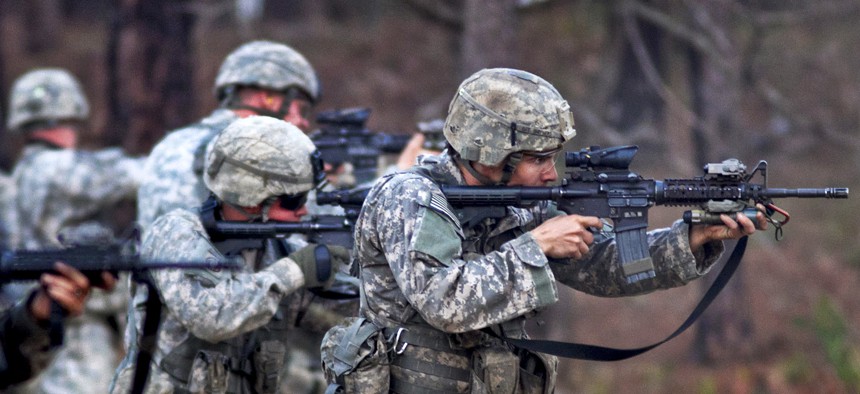
Scouts with the 82nd Airborne Division’s 1st Brigade Combat Team fire on a line during a course in advanced rifle marksmanship at Fort Bragg, N.C. U.S. Army / Sgt. Michael J. MacLeod
Rename US Army Bases for Heroes, not Confederates
Our soldiers should walk through gates that honor those who fought for the United States, not against it.
The tragic events in Charlottesville, Va., have re-opened the national debate over Confederate monuments and icons that stand in public spaces — and that includes the appropriateness of keeping ten U.S. Army installations named for Confederate officers. The question of renaming the bases was also raised after 2015’s Charleston church massacre, and military leaders declined to do so. This time, there should be no equivocation.
The Department of the Army must find alternatives to naming its installations after Confederate generals who took up arms against their nation and played significant roles in a rebellion that killed more Americans than the Second World War. While understanding and memorializing the Civil War itself is integral to U.S. military history as well as the history of the Army and its institutions, the lionizing and mythologizing of these individuals as standard-bearers of Army heritage must come to an end.
The ten installations — Camp Beauregard, La.; Fort Benning, Ga.; Fort Bragg, N.C.; Fort Gordon, Ga.; Fort A.P. Hill, Va.; Fort Hood, Texas; Fort Lee, Va.; Fort Pickett, Va.; Fort Polk, La.; and Fort Rucker, La. — were named for Confederate generals (plus Rucker, a colonel), including the military head of the armed rebellion (Lee) and the alleged head of the Ku Klux Klan in Georgia (Gordon). Beauregard’s forces shelled Fort Sumter on April 12, 1861, beginning the war that would claim over 600,000 American lives. In other words, not only did these individuals take up arms against the United States, they were instrumental in driving the rebellion, and some also worked to perpetuate the hatred that long outlasted the military conflict.
The Army has not seen this celebration of the Confederacy as problematic, arguing that the base names memorialize locally connected individuals, “not their causes or ideologies,” in the “spirit of reconciliation, not division.” An Army spokesperson repeated this excuse earlier this year in response to complaints about streets at Fort Hamilton, N.Y., named after Generals Lee and “Stonewall” Jackson. While technically correct about how the names came about, the Army’s answer is nonsensical with regards to the implications. Indeed, in the aftermath of the Civil War, even Robert E. Lee objected to calls for memorialization and monuments, believing they would foster not reconciliation but resentment. Likewise, it is as wrong to separate the placement of Confederate statues in public squares from the battle over segregation as it is to think that naming installations was just about locals wanting their base named after a finding a hometown hero. As the American Historical Association’s Jim Grossman has put it, “Confederate iconography has long been a way to clothe white supremacy in [the] garb of regional heritage.”
Renaming the bases may be bureaucratically arduous and politically uncomfortable, but there is no shortage of deserving and inspiring names. From the Second World War and Korean War era alone there are a host of generals who demonstrated selfless service and sacrifice. Why is there no Fort named after the legendary Gen. George Marshall, a five-star Chief of Staff who later served as Secretary of State and of Defense? What about Gen. Omar Bradley, the “soldiers’ soldier,” or the grenade-toting Matthew Ridgway? Either of these former commanders of the 82nd Airborne Division could easily replace the traitorous Braxton Bragg, who was also a pretty poor general. Gen. “Jumpin Jim” Gavin would make a fine replacement for Benning, one of the most vocal proponents of secession. Perhaps Hood, Lee, and Pickett could be replaced by Gens. Maxwell Taylor, James Van Fleet, or Anthony McAuliffe, famous for his response to the German request for surrender at the Battle of the Bulge: “Nuts.” Perhaps it is time for an installation named after Benjamin O. Davis, Sr. the Army’s first African-American general or in memory of Gen. William DePuy, who helped transform the modern Army. Bases named for Jack Galvin, the last SACEUR of the Cold War, or Colin Powell might be in order. What about a Fort (Anna Mae) Hays, after the first female general, or Fort (Ann) Dunwoody, the first woman to earn 4 stars? Perhaps we should look at our recent and continuing wars for heroes that represent exactly what our young men and women should take away from the names of the bases on which we serve. There are a dozen Army recipients of the Medal of Honor from the wars in Iraq and Afghanistan who could be honored by having installations named after them: Fort Groberg or Romesha would work quite well, as would Fort Hester, in honor of Sgt. Leigh Ann Hester, the first woman to have earned the Silver Star since World War II.
The point is that there are plenty of worthy heroes deserving of public memorialization who fought for the United States and its flag, not against it. It is time for the Army to correctly honor the legacy of those who fought before, during, and after the Civil War and accept that the images and icons of the Confederacy, while of historical value, are meant for graveyards and museums, not in public places of honor or bases where men and women defend the Constitution and stand prepared to make, if needed, the ultimate sacrifice.
